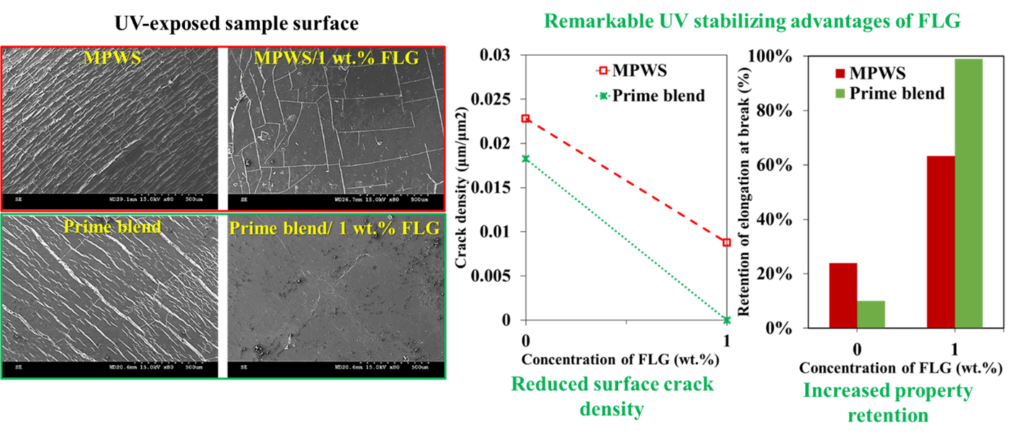Researcher Emna Helal and her team have investigated the use of plastic waste through the addition of graphene. Discover the summary of their work.
Summary
Globally, approximately 350 million metric tons (Mt) of plastic waste are generated annually, with roughly 50% comprising a polyolefin mixture of polyethylene (PE) and polypropylene (PP). Consequently, the imperative to devise effective strategies for improving the management of mixed polyolefins waste streams (MPWS) becomes evident. Such strategies would facilitate the utilization of a significant portion of plastic waste, which would otherwise be relegated to landfills.
Unfortunately, the phase-separated morphology and the presence of impurities compromise the properties of waste PE/PP mixtures. Additionally, polyolefin blends undergo photodegradation upon exposure to UV radiation, adversely affecting the structure and properties of PE and PP polymer chains. Hence, treatment of waste-recovered polyolefin mixtures is necessary to make them suitable for various applications. In this regard, graphene emerges as a promising reinforcement and photostabilizing filler for immiscible MPWS, owing to its lightweight and robust properties. Therefore, the primary objective of this study is to assess the impact of commercially produced few-layer graphene (FLG) on the morphological evolution, processability, mechanical properties, and photodegradation behavior of waste-recovered polyolefin mixtures. FLG was incorporated via melt-mixing into both prime PE/PP blends and PE/PP waste mixtures. This study demonstrates that FLG supplementation effectively increases the stiffness and retards the photodegradation processes of polyolefin blends, findings applicable to both recycled polyolefin blends and pristine polyolefin blends. To achieve enhanced photoprotection, a higher concentration of FLG is necessary for recycled polymer blends, than for prime blends (shown in the Figure), partly due to the predegraded state of MPWS. Furthermore, pretreating prime polyolefins with FLG could serve as a recommended measure, thereby prolonging their lifespan and yielding less degraded MPWS for potential reuse.

This work underscores the potential of graphene in strengthening and extending the lifespan of polyolefins, thereby decreasing the generation of plastic waste, through the addition of commercially available and low-cost graphene, produced in compliance with Canadian environmental regulations.
